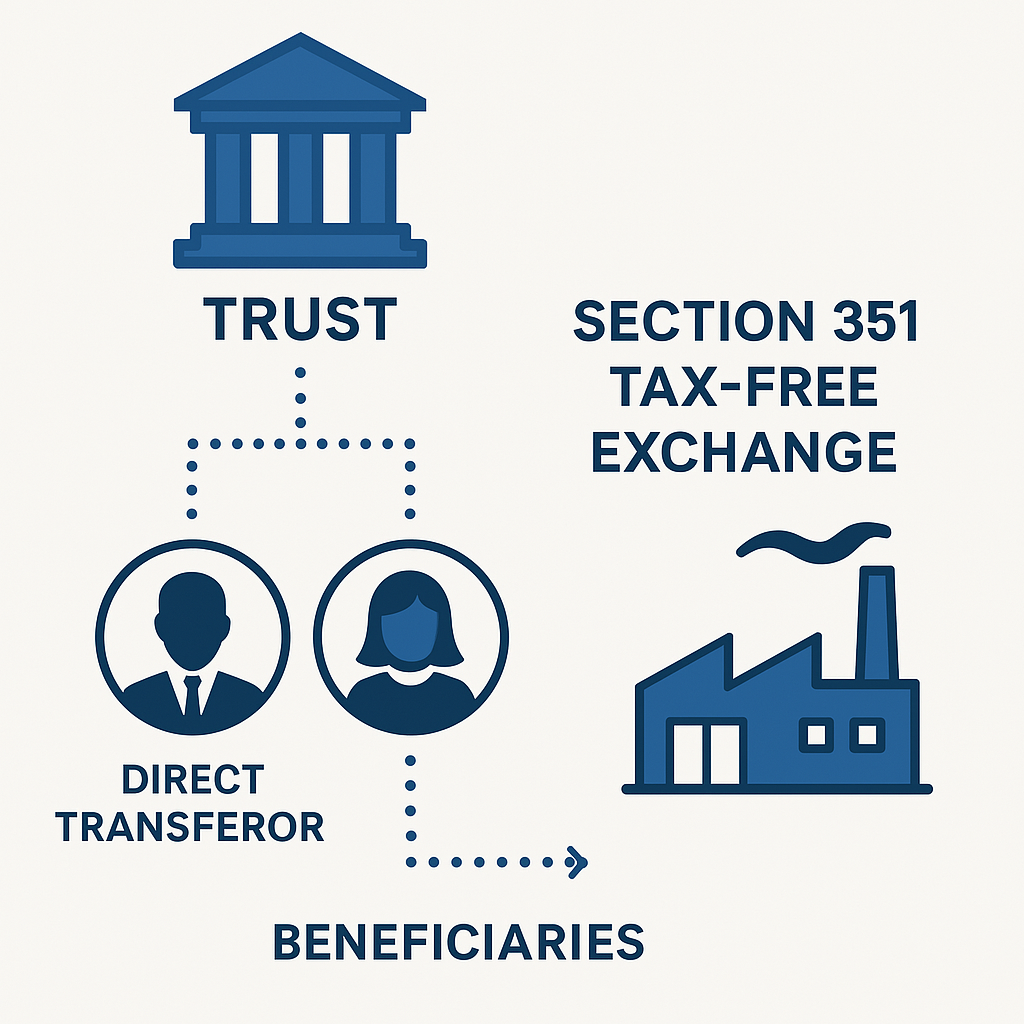Section 351 of the Internal Revenue Code represents one of the most valuable tax planning tools available for corporate transactions, allowing for the tax-free transfer of property to a corporation in exchange for stock. However, when trusts are involved in these transactions, practitioners often encounter uncertainty regarding the eligibility and treatment of these entities as transferors. This analysis examines the parameters under which trusts can successfully participate in Section 351 exchanges.
Understanding Section 351 Framework
Section 351 provides tax-free treatment when one or more persons transfer property to a corporation, provided that immediately after the transfer, those persons control at least 80% of the corporation’s voting power and total shares. The definition of “persons” under this provision extends beyond individuals to encompass various entity types, including partnerships, limited liability companies, foundations, and tax-exempt organizations.
Trusts can participate in Section 351 tax-free exchanges, either as direct transferors or through their beneficiaries, with proper structure and due diligence.
Trusts occupy a unique position within this framework, as their treatment depends fundamentally on their underlying structure and tax classification. The Internal Revenue Service recognizes trusts as eligible participants in Section 351 transactions, though the analysis requires careful consideration of the trust’s specific characteristics.
Trust Classification and Transferor Status
The determination of transferor status for trusts hinges on their tax classification, which generally falls into two distinct categories:
Complex and Standalone Taxpaying Trusts function as independent taxpayers for federal income tax purposes. These trusts maintain separate tax identities and file their own returns, making them straightforward candidates for Section 351 treatment. When such a trust transfers property to a corporation in exchange for stock, the trust itself qualifies as the transferor, assuming all other statutory requirements are satisfied.
Grantor and Simple Trusts present a more nuanced scenario due to their pass-through nature. Under the grantor trust rules or the conduit principle governing simple trusts, the beneficiaries are treated as the true owners of trust assets for tax purposes. In Section 351 contexts, this typically means the beneficiaries, rather than the trust itself, are considered the actual transferors. This classification does not preclude Section 351 treatment but requires analysis of the beneficiaries’ collective control position post-transaction.
Practical Considerations and Due Diligence
While trust participation in Section 351 exchanges generally yields favorable outcomes, practitioners must conduct thorough due diligence to ensure compliance. Each trust instrument contains unique provisions that may affect the determination of transferor status and control attribution. Key considerations include:
The trust’s governing document must be reviewed to understand the distribution of beneficial interests and the extent of trustee discretion. Additionally, the timing and nature of beneficial interests can impact whether beneficiaries qualify as transferors under Section 351. For multi-beneficiary trusts, practitioners must ensure that the collective control requirements are satisfied by the appropriate parties.
State law variations in trust governance may also influence federal tax treatment, requiring coordination between tax and estate planning counsel. Furthermore, any restrictions on the trust’s ability to hold corporate stock should be identified and addressed prior to the exchange.
Risk Assessment and Compliance
Experience demonstrates that most trust-related Section 351 transactions achieve their intended tax-free treatment when properly structured. However, the complexity inherent in trust taxation demands careful analysis of each situation’s specific facts and circumstances.
The key to successful implementation lies in early identification of the trust type, proper determination of transferor status, and verification that all control requirements are satisfied. While outcomes are generally favorable, the stakes involved in corporate restructuring transactions necessitate comprehensive review by qualified tax professionals.
Strategic Implications
Trust participation in Section 351 exchanges opens significant planning opportunities for families and institutional investors. These transactions can facilitate generational wealth transfer strategies, corporate restructurings, and tax-efficient business combinations while preserving the benefits of trust structures.
The ability to combine trust planning with corporate tax strategies provides sophisticated taxpayers with enhanced flexibility in achieving their business and personal objectives. However, success requires coordination among tax, legal, and financial advisors to ensure all regulatory requirements are satisfied.
Conclusion
Trusts can effectively participate in Section 351 tax-free exchanges, with the specific treatment depending on the trust’s tax classification and structure. Whether the trust itself or its beneficiaries qualify as transferors, proper analysis and documentation typically result in successful outcomes.
Given the complexity of these transactions and the significant tax consequences involved, practitioners should engage in comprehensive due diligence and seek appropriate professional guidance to ensure optimal results. The intersection of trust and corporate tax law demands expertise in both areas to navigate successfully and achieve the intended tax benefits.

